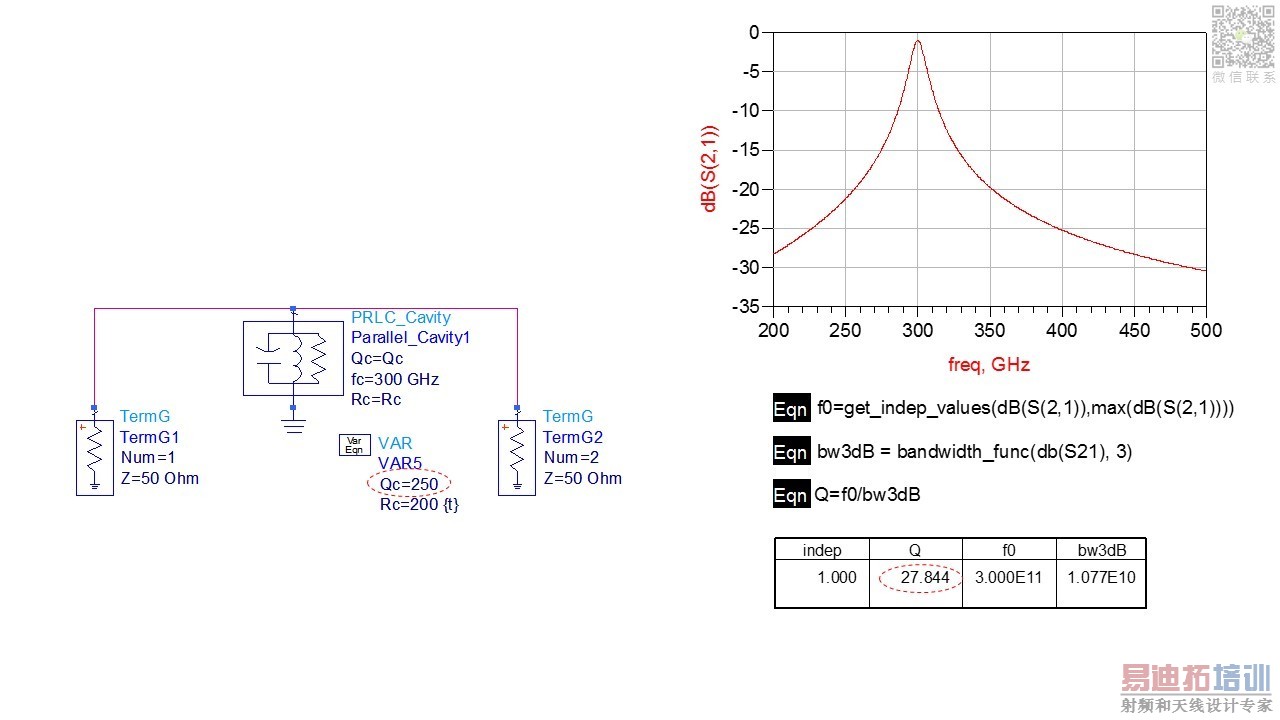- 易迪拓培训,专注于微波、射频、天线设计工程师的培养
Problem with Q-factor simulation in ADS
I encountered a problem of calculating Q-factor of a simple parallel RLC circuit in ADS. Attachment is the schematic and its S21 simulated result. In the schematic I set Q of the RLC circuit to be 250, however from the simulated S21 result, the calculated Q was just around 28.
I would sincerely appreciate if someone could clarify my problem.
Thanks alot and best regards,
Q of the loaded circuit will be reduced by connected 50 ohm source and load.
Thanks so much for your help!
By the way, could you please tell me if there is a way to calculate Q of the circuit regardless of effect of the source/load impedance in frequency domain analysis?
Dear FvM,
I just found one way to do such a purpose. I will set source/load impedance to a very high value (can be considered as infinity) to avoid their effect. By using this way, the loaded Q will be close to the unloaded Q.
Anyway, thanks a lot again for your kind help.
Q is by definition to be large with a large Resistor in parallel. Q is small because you have a 50ohm resistor on load as parallel.
Q=Rp/wL.
Don't use s-parameters.Do your s-parameters simulation but plot Zxx (Z11 or Z22) impedance curve because s-parameters are two way and therefore otherside's 50 Ohm port loads the circuit.
Thanks a lot for your suggested method. Do you mean I should calculate the unloaded Q from Z curves because Z is not dependent on the port impedances? If so I think this method is pretty good.
Thank you for your response. You are right, I think my method of using large port impedances was not correct since the resultant Q was still loaded but not unloaded.
That's right.Z-parameters are "Open Circuit Parameters" and while the simulator is computing them for one port, other port is assumed/mathematically forced being as open circuit so the loading effect is disappeared.
Thanks so much for your clear explanations, now I understood that!
申明:网友回复良莠不齐,仅供参考。如需专业帮助,请学习易迪拓培训专家讲授的ADS视频培训课程。
上一篇:pole/zero analysis in advance design system (ADS)
下一篇:How to overcome CONVERGENCE problem for our CKT using Agilent ADS2011.10
 国内最全面、最专业的Agilent ADS培训课程,可以帮助您从零开始,全面系统学习ADS设计应用【More..】
国内最全面、最专业的Agilent ADS培训课程,可以帮助您从零开始,全面系统学习ADS设计应用【More..】
- Agilent ADS教学培训课程套装
- 两周学会ADS2011、ADS2013视频教程
- ADS2012、ADS2013射频电路设计详解
- ADS高低阻抗线微带滤波器设计培训教程
- ADS混频器仿真分析实例视频培训课程
- ADS Momentum电磁仿真设计视频课程
- ADS射频电路与通信系统设计高级培训
- ADS Layout和电磁仿真设计培训视频
- ADS Workspace and Simulators Training Course
- ADS Circuit Simulation Training Course
- ADS Layout and EM Simulation Training Course
- Agilent ADS 内部原版培训教材合集

